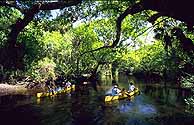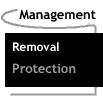
Everglades:
Management--Protection
 One
way to protect the Everglades from future removal and possibly return some
of the original area to its wetlands status is by restoring the natural
flow of water through the region. Many species
of plants and animals use the water for habitat, breeding and hunting
grounds, and camouflage. Their survival depends upon having enough water.
Water is also a key factor in ecotourism
at the Everglades National Park. The park requires water for such
recreational activities as fishing and boating. Photo:
Canoeing on St. Lucie River. Photo courtesy of South Florida Water
Management District.
One
way to protect the Everglades from future removal and possibly return some
of the original area to its wetlands status is by restoring the natural
flow of water through the region. Many species
of plants and animals use the water for habitat, breeding and hunting
grounds, and camouflage. Their survival depends upon having enough water.
Water is also a key factor in ecotourism
at the Everglades National Park. The park requires water for such
recreational activities as fishing and boating. Photo:
Canoeing on St. Lucie River. Photo courtesy of South Florida Water
Management District.
One effort to restore the Everglades to its original state includes the purchase of land surrounding the Everglades National Park to create buffer zones that distance people and pollutants from the park. In 1989, President George Bush purchased107,000 acres to establish a buffer zone near the park. In 1997, Vice President Al Gore purchased another 50,000 acres for this purpose. This land may increase the natural flow of water through the Everglades, increase habitat for plants and animals, and decrease agricultural pollution where the land purchased was farmland.
Another effort to restore the Everglades to its original state is through legislation. In 1989, the Everglades National Park (ENP) Protection and Expansion Act was established. The purpose of this Act is to increase park protection and assure better management of its resources. That same year the ENP Protection and Expansion Act authorized the Mod Waters Project. The goal of this project is to restore the natural flow of water to the ENP in order to restore its ecosystem. However, it was soon realized that merely pumping water into the Everglades with no regard for the quality, quantity, or the timing of the flow was not succeeding in restoring the wetlands ecosystem.
 In
1994, the Everglades Forever Act was passed. This Act provided for a
comprehensive clean-up/restoration plan. It addressed the problems of
quality, quantity, and timing of restored waterflow. This law also called
for action to stop exotic (not native) species of plants from spreading
further throughout the Everglades. Photo:
Exotic melaleuca trees invade the Everglades. Photo
courtesy of South Florida Water Management District.
In
1994, the Everglades Forever Act was passed. This Act provided for a
comprehensive clean-up/restoration plan. It addressed the problems of
quality, quantity, and timing of restored waterflow. This law also called
for action to stop exotic (not native) species of plants from spreading
further throughout the Everglades. Photo:
Exotic melaleuca trees invade the Everglades. Photo
courtesy of South Florida Water Management District.
The Everglades Forever Act of 1994 was followed by the Federal Water Resources Development Act of 1996 which provides for a
"restudy" of water management in central and southern Florida. One goal of the federal "restudy" is to decide how surrounding land should be managed. Should it be purchased or left alone? Many of the changes in the Everglades are the result of canals and dams installed by the Army Corps of Engineers to control water flow and protect against floods. For this reason, the Federal Water Resources Development Act of 1996 required the Corps to recommend a
plan by July 1, 1999 to restore the natural water flow of the Everglades.
For more information on Everglades legislation, visit the Everglades Information Network.
Overview
..|..
Species ..|..
Management
Removal
/ Protection
Glossary
..|..
Related
Links
..|..
References
|..PBL
Model
Home ..|.. Teacher Pages ..|.. Modules & Activities
HTML code by Chris
Kreger
Maintained by ETE Team
Last updated
April 28, 2005
Some images © 2004 www.clipart.com
Privacy Statement and Copyright © 1997-2004 by Wheeling Jesuit University/NASA-supported Classroom of the Future. All rights reserved.
Center for Educational Technologies, Circuit Board/Apple graphic logo, and COTF Classroom of the Future logo are registered trademarks of Wheeling Jesuit University.

